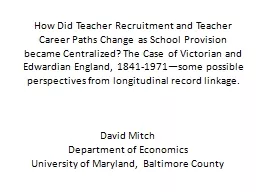

Centralized The Case of Victorian and Edwardian England 18411971some possible perspectives from longitudinal record linkage David Mitch Department of Economics University of Maryland Baltimore County ID: 396198
Download Presentation The PPT/PDF document "How Did Teacher Recruitment and Teacher ..." is the property of its rightful owner. Permission is granted to download and print the materials on this web site for personal, non-commercial use only, and to display it on your personal computer provided you do not modify the materials and that you retain all copyright notices contained in the materials. By downloading content from our website, you accept the terms of this agreement.
Slide1
How Did Teacher Recruitment and Teacher Career Paths Change as School Provision became Centralized? The Case of Victorian and Edwardian England, 1841-1971—some possible perspectives from longitudinal record linkage.
David Mitch
Department of Economics
University of Maryland, Baltimore CountySlide2
a)Period 1841 to 1911 saw the advent of centralized government funding and management of schools. Beginning in 1862, parliamentary funding to schools depended on examination results.
b)this resulted in the establishment of centralized provision of teacher training colleges and procedures for teacher certification.
Historical ContextSlide3
c)this also resulted in a substantial expansion of teaching occupations relative to the male and female labor force as a whole :
1841
1851
1861
1871
1881189119011911Male 0.5%0.5%0.67%0.5%0.66%0.7%0.58%0.6%Female2.0%2.8%3.0%3.1%3.9%4.1%4.1%3.8%
Teachers, school masters, school mistresses as percentage of total male and female labor force in England and Wales 1841 to 1891Slide4
Most teachers were female
1841
1851
1861
1871
1881189159.4%70.5%71.7%73.4%71.9%71.1%Percentage of teachers who were femaleSlide5
d)Census data for the end of the period indicate that most female teachers were unmarried:
In
the 1901 census, 92.3% of females in teaching related occupations were unmarriedAnd in the 1911 census, 91.7 %
were single, 6.3 % married, and 2% were widows. Slide6
Research questions to address with longitudinal data
a. What
were the social origins of teachers in the early Victorian period?
Were
teachers primarily recruited from those with skilled manual and lower middle class parents?
b. Did the social origins of teachers change over the 19th century with the relative expansion of the teaching workforce?i)Did the expansion of the teaching workforce provide more opportunities for upward social mobility?ii)Alternatively, did rising standards for teacher certification decrease recruitment from those with working class parents Slide7
Research Questions (continued):
c)What were the trends in teacher turnover and tenure with increasing centralized regulation of teacher certification and the implementation of funding and pay for performance policies?
d)how
did length of duration and spells of interruption in teaching, and occupational career patterns differ between males, single females and females who married
?
e)What changes occurred over time in the length of duration, spells of interruption and occupational career patters in teaching between 1841 and 1911?Slide8
Some perspectives from trends in age structure of the teaching workforce
Male
School master
Male
Teacher
FemaleSchoolMistressFemale School mistress marriedFemale TeacherFemale Governess185121%32.5%21.7%39.4%187117.9%60.1%22.35%53.7%188148.8%19.5%53.3%42.1%
1891
36.3%
53.1%
1901
28.8%
53.7% Unmarried
1.93%
Percentage of various categories of teachers under the age of 25---the use of categories changes across censusesSlide9
Procedures for constructing longitudinal data bases of teachers between 1841 and 1911:
1.Use a)1851 and 1881 Census CDs from Family History Resource File b)ancestry.com, c)Findmypast.com to generate names of those with teaching related occupational key words (teacher, school mistress, school master) from the 1851 and 1881 census.
2.Enter
Birmingham, Warwickshire, Norfolk locations---seems required to search on the occupational field.
2A: Issue of sampling strategy by location.:
i)cluster sampling ii)construct samples from contrasting census districts—rural/urban etc. iii)construct nationally representative sample? 3)link names of those listing teaching related occupations in 1851 and 1881 to earlier and later censuses (1841 through 1911) using ancestry.com and findmypast.com. Slide10
4)to construct career paths for women who married, employ marriage registers to identify females reporting a teaching related occupation at marriage. This identifies of occupation of father at marriage. Link the bride’s maiden name to census records prior to marriage, using name of father as well. Link the bride’s married name to subsequent census records. Slide11
Some VERY preliminary resultsSlide12
A.1881 data base of about 70 Warwickshire teachers.
Name
Year
Age
Location (Parish)
ConditionOccupationMother's OccupationFather's OccupationAgnes Hobson18617GoldingtonUnmarriedScholarNoneGentleman188128Warwick St NicholasUnmarriedTeacher1891
37
Brighton
Unmarried
Governess
1901
48
Easingwood
Unmarried
Governess
Tanner and Tithe Agent
Tanner and Currier
1911
58
Easingwood
Unmarried
None
Alice
E
Schofield
1871
9
St Giles
Unmarried
Scholar
None
--
1881
18
Aston
Unmarried
School Mistress
School Mistress
Coal Agent
1891
30
Handsworth
Unmarried
Governess
None
Living on Own Means
Alice O'dwyer
1851
13
Clayton Le Woods
Unmarried
Daily Attending School
Teacher of Music
Teacher
1881
43
Birmingham
Unmarried
Teacher
1891
53
North Meols
Unmarried
Certificated Teacher
1901
63
Glossop
Unmarried
School TeacherSlide13
Social origins of 1881 Warwickshire teachers
Father’s Occupational Category
n
%
Teacher
34.20% Skilled4258.30% Agricultural Labourer56.90% Commercial/Professional2230.50% Total72 Slide14
B.Data Base for Norfolk teachers, 1851 and 1881
i.social
origins 1851 N = 52
Percent with fathers
Agricultural Labourer 17.35% School Master 5.80% Farmer 9.60% Commercial/Professional 25% Skilled 42.40%Percent with mothers who were school mistresses 4/27 = 14.8%Slide15
Social origins Norfolk teachers1881
Father’s occupation:
Mother’s occupationSurgeon School Mistress (3)
Farm Steward Fund Holder
Collier
ManSchool MasterPainterRailway PorterWatermanCabinet MakerPorterSlide16
ii.Tenure patterns of females who were teachers in Norfolk
1851:
Occupational title in 1851 Teacher:Listing
across Multiple census of a teaching
occupation:
16 Single listing of a teaching occupation: 21Occupational title in 1851 School Mistress: listing across multiple censuses of teaching related occupation: 24 Single listing of teaching occupation: 191881:Occupational title in 1881 School Mistress:Listing in multiple census of teaching related occupation: 12 Single listing of Teaching related occupation: 6